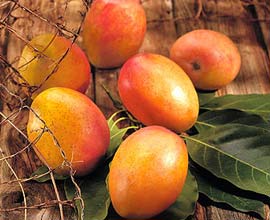Preserving mangoes and labels
Most of the labels and mangoes consumed on the market today are stored in bamboo baskets, wooden crates and cartons in natural conditions, so they are affected by temperature, high humidity and transport far away, so it is recommended managed for 7-10 days, crushing rate to 20-25%, sometimes up to 30%. Research institutes and universities have successfully researched and applied some methods of preserving fresh mangoes and labels as follows:
- Technology of preserving fresh fruits at normal temperature using fungicides, microorganisms and insects by steaming SO 2 and methods of changing environmental preservation ingredients. This technology can be stored for 15 - 16 days, with a loss rate of 10-12%, can be transported far away from the Southern provinces to the North.
- Technology of preserving fresh fruit for mango at low temperature of 10-12 o C, with label 5-7 o C is the most effective preservation method, the preservation time lasts more than 30 days, the loss rate due to 5 - 7% crushing, it can be transported far away and exported (before storage at low temperature, it is necessary to remove rotten, crushed and processed fruits as mentioned above). With mangoes stored at natural temperature (as in our country) the holding time is very short. Song preserved at low temperature below 10 o C, mango fruit has many limitations: Vulnerable to cold temperatures make fruits change color, tender meat, taste is not as typical as normal ripening. Mango after harvest, sort, rinse and soak in CaCl 2 or Ca (NO 3 ) 2 solution , use concentration of 4-6%, remove it to dry in natural conditions, then put in bag nylon size 15 x 25 cm, with 20 moisture holes in the bag. Preserving at 11 - 11.5 o C temperature is the best, the preservation time is over 30 days, mango still retains the good color and quality (VNCCAQ MN).
 - About packaging preservation labels and mangoes:
- About packaging preservation labels and mangoes:
1. A traditional type of bamboo baskets, wooden crates (each stick) has low cost but high rate of crushing and rotting.
2. Using carton boxes with perforated moisture holes, costs are higher than traditional ones but the rate of loss, crushing, and rotting is much less so the final effect is still high.
In addition to fresh preservation, for labels, the drying method is also used to prepare and preserve dried fruit and dried longan (dried pulp). Currently, applying the method of drying the pulp by twisting the seed at the prison when the fruit is still fresh, while still retaining the shape of fruit and low fuel consumption. The amount of recovery put into drying accounts for 30-35% of the total output. Drying technology is manual, using charcoal and coal. The drying capacity of the kilns averaged from 8-10 tons / batch, up to 20 tons / batch; 1-batch drying time from 24 to 48 hours. The kilns are usually concentrated around the labeling area, particularly Ben Tre province has over 100 kilns.
Because the process of drying technology is still obsolete, the product quality is not high, uneven in color, shape, and does not meet the market requirements of some fastidious countries.
Processing
Labels and mangoes are processed with many kinds of products such as sugar soaked labels, syrups, water labels and mango drinks. Currently there are 8 export food processing factories namely Deltafood, LD Donanewtower, Interfood, Tan Binh, Delta Long An, Tien Giang, An Giang, Kien Giang; total capacity of 65,500 tons of products per year. The consumer market of these products is still very limited and high cost (packaging cost accounts for 20% of product cost), beverage products are mainly consumed domestically but still slow. so factories have not fully utilized their capacity.
- Notes when eating labels to keep your body healthy
- It's hard to believe the sticker helps fresh fruit for 10 days longer and is absolutely safe!
- The initiative helps turn clothing labels into living things
- Selection of top-line labels to preserve specialty varieties
- Longan to make medicine
- 2 fruits should be eaten daily
- In the past, there was no refrigerator, what was the food preservation?
- Anti-counterfeiting label thanks to the image displayed by the breath
- An Australian farmer developed a mango-flavored coconut variety
- Shelf life of meat types
- Interesting benefits of mango fruit
- Eating mangoes can prevent breast cancer
 'Barefoot engineer' invents a pipeless pump
'Barefoot engineer' invents a pipeless pump Process of handling dead pigs due to disease
Process of handling dead pigs due to disease Radiometer
Radiometer Warp Engine: Technology brings us closer to the speed of light
Warp Engine: Technology brings us closer to the speed of light